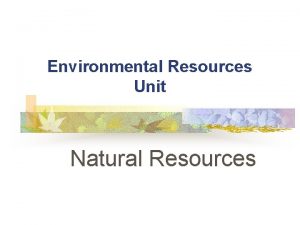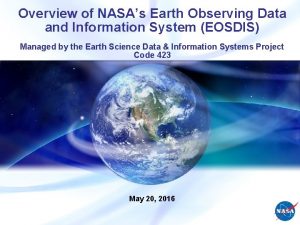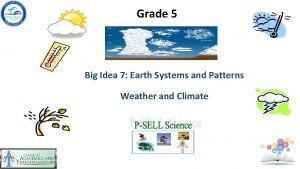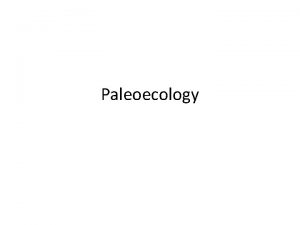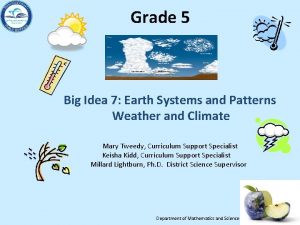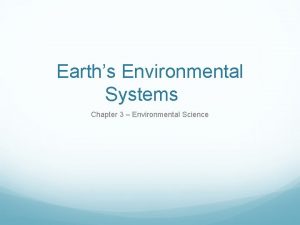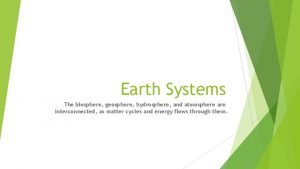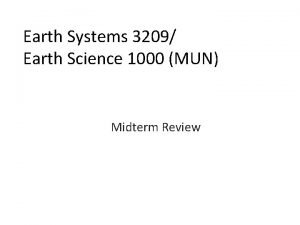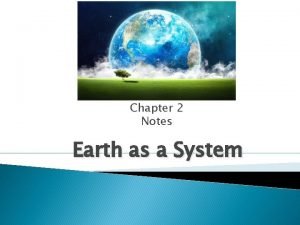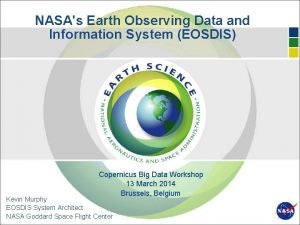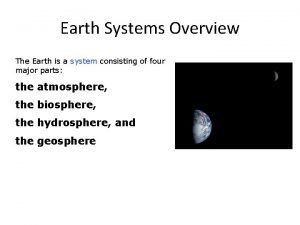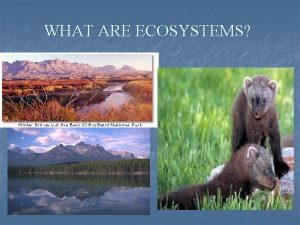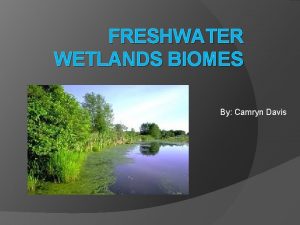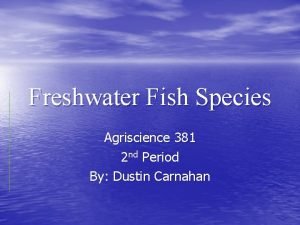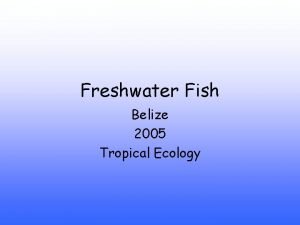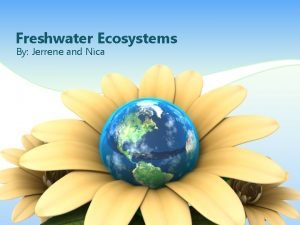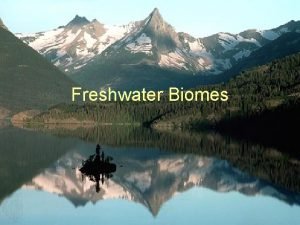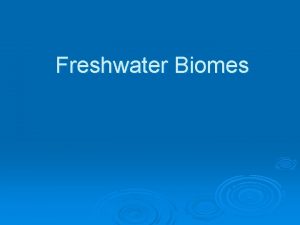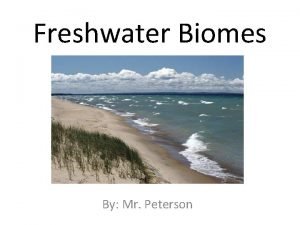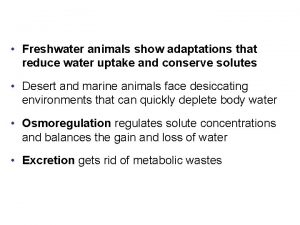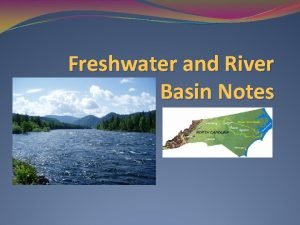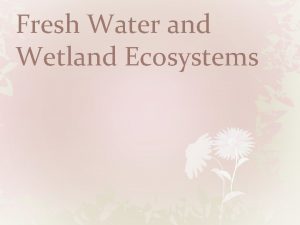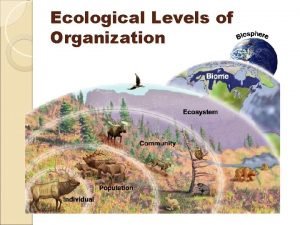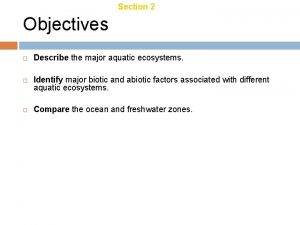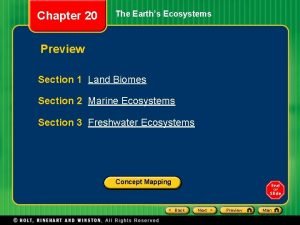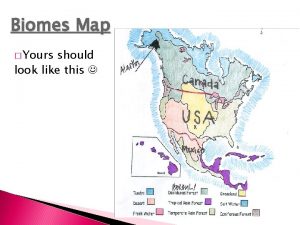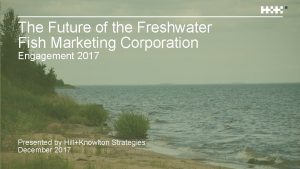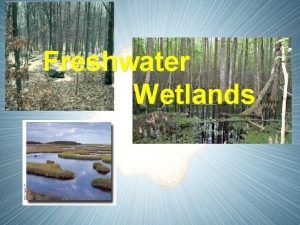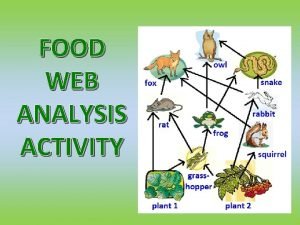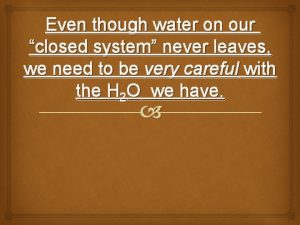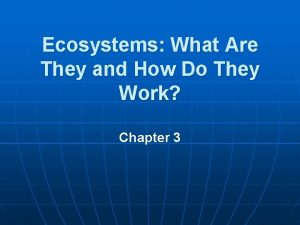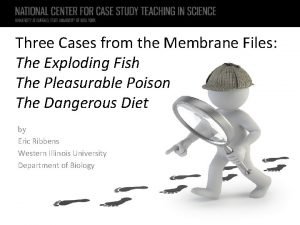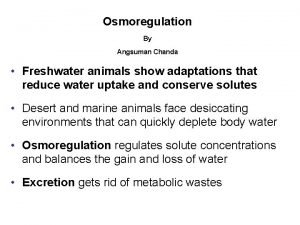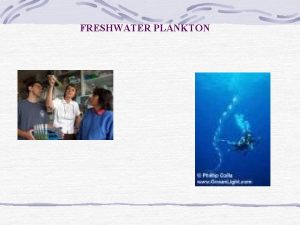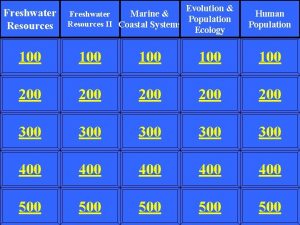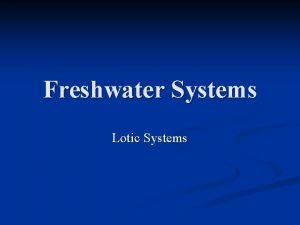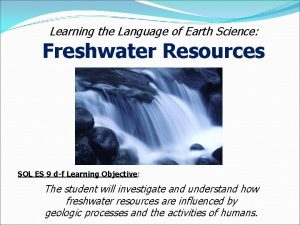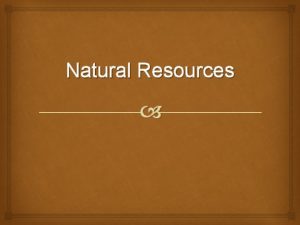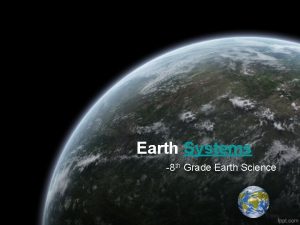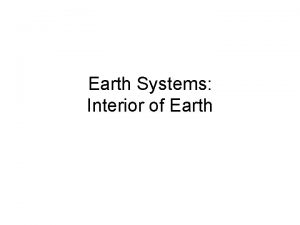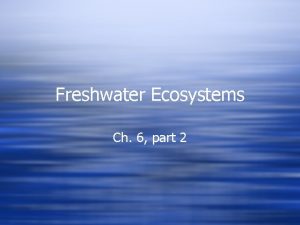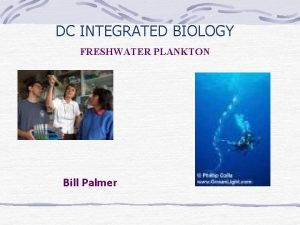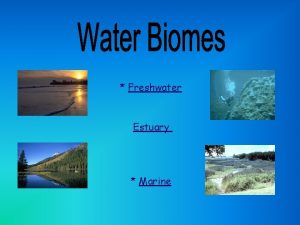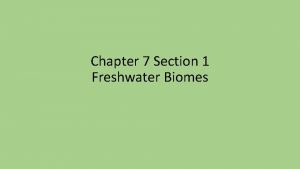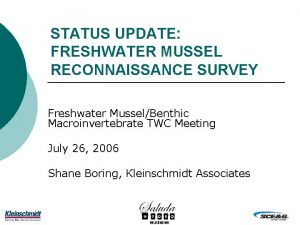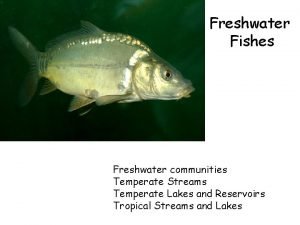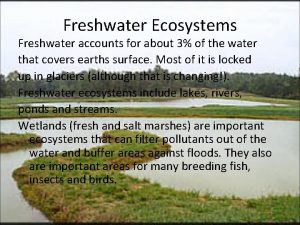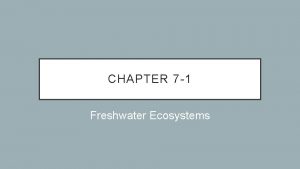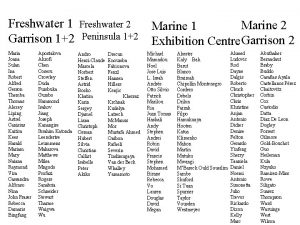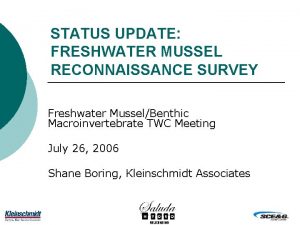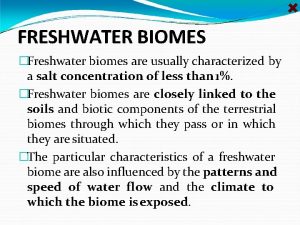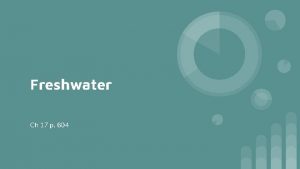Freshwater Resources Freshwater Systems 97 5 of Earth










































- Slides: 42

Freshwater Resources

Freshwater Systems � 97. 5% of Earth is water, only 2. 5% is freshwater �Freshwater – water that is relatively pure, with few dissolved salts �Most freshwater is locked up in polar icecaps and icebergs, and underground aquifers � Only 1 part in 10, 000 is available for human use



�Hydrologic Cycle �Water carries nutrients and sediments to the oceans from rivers �Distributes nutrients and sediments in the ocean through currents �Hydrologic cycle – summarizes how water in its three forms flow through our environment � Evaporation – conversion of liquid water into a gaseous state � Warm temperatures speed up evaporation � Areas of less growth will lose more water � Transpiration – release of water vapor from plants through their leaves � Strong winds and/or higher temperatures speed up transpiration

�Precipitation- water vapor condenses and falls as rain or snow from Earth’s atmosphere � Plants will use water this way � Most is lost as runoff into lakes, ponds, rivers, oceans, and streams �Groundwater – water under the surface that gets recharged by precipitation or surface water � Water soaks through into aquifers � Water table – the upper limit of groundwater held in an aquifer, aquifer


Human Impacts on the Hydrologic Cycle - damming rivers creating reservoirs -destroys habitat by flooding land previously not underwater

Impacts con’t �Increase evaporation by clearing lands �Increase surface water and runoff �By eliminating farm lands and forest, we reduce the amount of vegetation, reducing transpiration �Overdrawing groundwater for use depleting our water resource


How we use water �Household use, Agricultural, and Industry �Nations with dry climates use more water for agriculture. �Heavily industrialized nations use more water. �Globally, we use 70% of freshwater for agriculture, 20% for industry, and residential/municipal accounts for 10%.

�Types of Use � Consumptive Use – we remove water from an aquifer or surface water and do not return it � Nonconsumptive Use – water does not remove, or only temporarily removes water from an aquifer or surface water body � Example: Dam

Surface Water �Surface water – water found on Earth’s Surface � Sources include rainfall, melting snow, glaciers, and ice caps � Surface water moves from these sources to bodies of surface water as runoff �Runoff – water that flows over land that is not absorbed into the ground �River system – network of connected streams and rivers that form as water moves downhill �Water moves in the following progression � Shallow groves in the Earth’s crust stream small river (tributaries) large body of water stream large river

River Systems of NJ Mullica River System

�Watersheds – includes all of the land area that supplies water to a particular river system �Watershed structure – there are 9 major watersheds that make up the US � Each is made up of many different watersheds �Managing Watersheds – upstream pollution will have negative effects on the downstream watershed � Requires cooperation of all individuals who live within the watershed

Using Surface Water �Diverting water �Water diversion – the process of moving from its source to places where humans use it � Dam – an obstruction placed in a river or stream to block its flow � Creates an artificial reservoir (lakes that store water for human use) � There are 80, 000 dams in use in the US. � Canal – water diverted from a river to irrigate farmlands that are not near any surface water resources

Costs and Benefits of Dams Costs Benefits �Habitat alteration �Fisheries decline �Population displacement �Sediment capture �Loss of fertile farmland �Risk of failure �Lost recreational opportunities �Clean power generation � Hydroelectric �Crop irrigation �Flood control �Shipping �New recreational opportunities

�Surface water depletion �Drought and overuse contribute most to depletion of surface water � Dried-up rivers – too much water is diverted upstream, therefore, eliminating water flow downstream in heavily used areas � The Aral Sea – two rivers were diverted to irrigate thirsty cotton fields � The rivers flood the Aral Sea, but since the diversion, the sea has shrunk to 10% of its original size. � 60, 000 fishing jobs were lost.

Using Groundwater �Groundwater is being used primarily for irrigation faster than it can be replenished. �Agricultural Uses – 26% of the freshwater used in the US comes from groundwater; of that 68% is used for irrigation �Most water is lost to run-off and evaporation �Too much water can be detrimental. � Waterlogging – the soil becomes saturated with water to the point that oxygen no longer gets in � Salinization – buildup of salts in the surface layers of soil.

�Groundwater Mining � 18% of groundwater goes to public use for drinking, washing, etc. . � Groundwater mining – using groundwater faster than it can be replaced � Turn water into a nonrenewable resource � Lowers the amount of water in aquifers � Drops the water tables – causes land over top to become weak, not being able to support it � Sinkholes – areas where the ground gives way swallowing up everything on the surface

�Groundwater Depletion �As mining increases, the volume of water in the aquifer decreases �As groundwater leaves, salt water travels through cracks in the stone contaminating the remaining freshwater with high salt concentrations. �Causes streets to buckle, buildings that flood, pipes to break, building to lean.

http: //edro. wordpress. com/2008/02/

Solutions to Freshwater Depeletion �Solutions that increase supply �Desalination – the technology of removing salt from saltwater to make freshwater � Methods One method: boiling seawater to produce water vapor, then condense (cool) the vapor in order to collect the water � Reverse osmosis – forces water through artificial membranes to filter out salts � Very expensive � Requires a lot of Energy �

�Solutions that Reduce Demand �Agricultural Solutions � Drip irrigation system � Less water lost to evaporation � Climate-appropriate crops � Less water needed to grow �Industrial Solutions � Companies have contracts with municipalities for certain amounts of water; recycle wastewater �Personal Solutions � Watering at night � Chose outdoor plants adapted to the conditions � Called xeriscaping � Low flow toilets, showers, sinks � Fixing leaky pipes

Water Pollution �Types of Water Pollution �Point-Source Pollution – pollution that comes from a distinct locations such as a factory or sewer pipe �Nonpoint-Source Pollution – pollution that comes from many places over a large area � Watershed pollution carries all runoff to large bodies of water

�Nutrient Pollution – areas of water that have a high nutrient content but low oxygen content are called eutrophic �Eutrophication – natural process of the build up of nutrients in a body of water � Freshwater usually has a build-up of phosphorus � How it happens; � As phosphorus levels rise, so does the population of algae and aquatic plants � More growth means more death; which leads to decomposition of dead organic material � Decomposition requires oxygen which lowers the oxygen levels in the water � End result is a high nutrient low oxygen containing body of water…………. . Eutrophic


�Cultural Eutrophication – nutrient pollution by humans, also called artificial eutrophication �Usually occurs because of non-point source pollution from fertilizers and detergents carried in runoff � Causes algal blooms – explosions in algal populations due to the increase in phosphorus � May cover the entire surface of a body of water; blocks sunlight for photosynthesis, decomposition increases, oxygen levels decrease


�Toxic-Chemical Pollution – organic or inorganic pollutants in the freshwater �Petroleum (plastics, mercury, arsenic, lead) �Sediment Pollution – more sediment being deposited down river causing photosynthesis rates to change, causing food webs to collapse �Is a result of erosion; mostly man-made. �Thermal Pollution – the warmer water is, the less oxygen it can hold (increased molecular motion) �Industrial processes use water to cool down machinery � When the water is returned, it is warmer than when it started �Removal of trees; addition of trees

�Biological Pollution – disease causing pathogens make their way into soil and water �Human or animal waste �Causes more health problems than any other pollution type �Access to clean water will reduce the death toll due to contaminated drinking water � Most deaths occur in South Asia and sub-Saharan Africa in young children

Groundwater Pollution �Sources �Human intervention is the reason why groundwater pollution is so widespread. � Chemicals from fertilizers and pesticides leach down (soak) into aquifers. � Leaky wells and faulty storage tanks from industry also add to this problem.


�Cleaning up Groundwater �Natural processes do filter away pollutants, however, it takes many years. � DDT is still found in underground water although its use was banned in 1972. �Decomposition is slower in groundwater than in surface water. � Why? Less microbes, does not move as much, takes a long time to recharge �How can groundwater be cleaned up? � Locate and repair gasoline tanks, sewage tanks, oil tanks, etc. .

Ocean water Pollution �Oil Pollution �Most oils spillage comes from small nonpoint-sources such as small boats, runoff from human activities on land. �Oil coats and kills marine organisms, shattering food webs. �Oil Pollution Act – set aside $1 billion for prevention and cleanup � Mandates leaks that oil tankers have a double hull to prevent oil

http: //www. youtube. com/watch? v=o. ILB 2 L wf. KYo

�Mercury Pollution �Mercury is a toxic heavy metal that collects in the tissues of marine organisms. �Makes its way up the food chain by biological magnification.

Biological Magnification of DDT in a Food Chain Concentration of DDT in A Long Island Marsh sprayed for Mosquito Control 1967 ppm Water . 00005 Plankton . 04 Silverside Minnow . 23 Sheephead Minnow . 94 Pickerel 1. 23 Needlefish 2. 07 Heron 3. 57 Tern 3. 91 Osprey 13. 8 Merganser 22. 8 Cormorant 26. 4

�Nutrient Pollution in the Ocean �Nitrogen effects the oceans in the same way phosphorus effects freshwater systems. �Red Tides – algal blooms in the ocean cause red pigments to be produced and released into the food chain. � Pigments may cause illness and death among zooplankton, fish, marine mammals, birds, and humans. �The only way to stop this is to reduce nutrient runoff from land.

Controlling Water Pollution �The Clean Water Act of 1977 �Made it illegal to release pollution from point source without a permit �Set standards for pollution levels in surface water and industrial wastewater �Water Treatment �Drinking water treatment – EPA set standards for 80 possible contaminants �Wastewater Treatment – water from homes, industry, farming

Water Treatment Facility

Septic System Septic systems are the most popular method of wastewater disposal in rural areas of the U. S.
 Difference between transforming and transformed resources
Difference between transforming and transformed resources Fixed and variable resources examples
Fixed and variable resources examples Renewable vs nonrenewable resources worksheet
Renewable vs nonrenewable resources worksheet Chapter 27 human impact on earth resources
Chapter 27 human impact on earth resources Earth resources examples
Earth resources examples How do people destroy natural resources
How do people destroy natural resources Natural resources examples list
Natural resources examples list Earth resources kitty hawk
Earth resources kitty hawk Comparing economic systems worksheet
Comparing economic systems worksheet Collab crib (2021) userscloud.com
Collab crib (2021) userscloud.com Big idea 7: earth systems and patterns answer key
Big idea 7: earth systems and patterns answer key Earth systems
Earth systems Big idea 7 earth systems and patterns
Big idea 7 earth systems and patterns Earth's environmental systems chapter 3
Earth's environmental systems chapter 3 Geosphere
Geosphere Earth systems 3209
Earth systems 3209 Earth's spheres foldable
Earth's spheres foldable Earth observing systems data analytics
Earth observing systems data analytics Hydrosphere
Hydrosphere The shape of the earth
The shape of the earth Freshwater non living things
Freshwater non living things Climate of freshwater wetlands
Climate of freshwater wetlands Texas freshwater fish species
Texas freshwater fish species Saber toothed anchovy biome
Saber toothed anchovy biome Freshwater biome biotic factors
Freshwater biome biotic factors Freshwater biome temperature
Freshwater biome temperature 2 ducks
2 ducks Freshwater biomes facts
Freshwater biomes facts Freshwater animals adaptations
Freshwater animals adaptations Freshwater basin
Freshwater basin Description of freshwater
Description of freshwater Ecosystem foldable
Ecosystem foldable Freshwater zones diagram
Freshwater zones diagram Freshwater ecosystem abiotic factors
Freshwater ecosystem abiotic factors Map of freshwater biome
Map of freshwater biome Freshwater fish marketing
Freshwater fish marketing Freshwater wetlands purify water by
Freshwater wetlands purify water by Food chain examples
Food chain examples Pie chart of freshwater and saltwater
Pie chart of freshwater and saltwater Tertiary consumers in freshwater
Tertiary consumers in freshwater Chapter 14 water resources answer key
Chapter 14 water resources answer key Saltwater fish in freshwater explode
Saltwater fish in freshwater explode Freshwater animal adaptations
Freshwater animal adaptations





